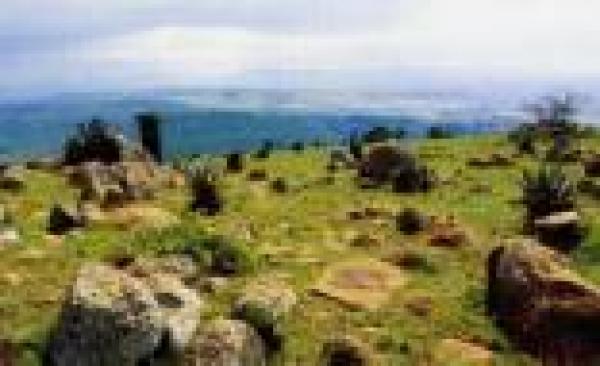A tranquil sense of solitude greets the visitor to Spioenkop, 30 km south of Ladysmith, the site of one of the most fearsome events of the Anglo-Boer War.
Recalling the battle of Spioenkop, the Boer commander, Denys Reitz, wrote, 'There cannot have been many battlefields where there was such an accumulation of horrors within so small a compass.' A century later, it is hard to imagine that it was on this quiet, sunlit hill that Boer and Brit fought one another in the bloodiest battle of the Anglo-Boer War.
At the turn of the century the Boers had occupied much of Natal and were ranged along the Tugela in preparation for an onslaught into the Natal heartland. They whipped the British on several fronts, the most humiliating British defeat being the Battle of Colenso where the toll of over a thousand British casualties to only eight Boers was a severe blow to British national pride.
In January 1900, the commander of the British forces, General Sir Redvers Buller (who had done little to distinguish himself since being sent to rout the invading Boers) crossed the Tugela and, together with General Sir Charles Warren, planned a two-pronged attack to outflank the Boers and advance on Ladysmith - which, although held by the British, was besieged by the Boers.
Boer forces in the area numbered only five or six hundred men, so the armies had to advance without delay if they were to succeed. However, Warren procrastinated for several days, during which time the Boers reinforced their numbers.
Buller eventually lost patience and gave Warren an ultimatum - move on Ladysmith or retreat across the Tugela. Warren's decision was to take and hold Spioenkop, the commanding hill which seemed to be the key to relieving Ladysmith. On the night of 23 January 1900 he sent about 1 700 men to storm Spioenkop under cover of darkness. The men began the long climb up the southwestern ridge of Spioenkop in a steady drizzle. When they reached an open slope below the summit five hours later, they were ordered to fix their bayonets. Just metres away in the darkness a slumbering Boer party of men were woken to the chilling clatter of hundreds of bayonets fixing into their sockets. Firing wildly, all but one of the Boers escaped into the darkness.
At 2am both Boer and British camps 400m below heard the troops cheer as they crested the summit. But the British triumph was misplaced. One advantage the Boers had was their familiarity with the area's topography and terrain. Warren had ordered the attack on Spioenkop without any prior reconnaissance - and did not realise that, viewed from the north, Spioenkop was not the bastion it appeared to be from the south. The Boers moved seven pieces of artillery onto the surrounding hills and prepared for battle.
On the summit of Spioenkop the British began to dig a trench but soon struck rock below the surface and could manage only a shallow ditch less than half a metre deep. At dawn a thick mist shrouded the summit and when it began to lift at around 7 am, the full horror of their situation became clear - the summit was totally exposed to the surrounding hills.
An hour later, when the mist finally lifted, Boer forces engaged the British in ferocious hand-to-hand battle. This was followed in the aftemoon by a relentless shelling of British reinforcements arriving on the scene. Boer shells rained down with deadly accuracy, sometimes at a rate of seven a minute, turning the summit into a hell of splintering rock, flying metal and shattered bodies.
Winston Churchill, as a war correspondent witnessing the battle, wrote: 'Many of the wounds were of a horrible nature. The splinters and fragments of the shells had torn and mutilated in the most ghastly manner.' The British finally succeeded in breaching the Boer lines by evening, and to secure the hill they had only to bring in more reinforcements.
However, a combination of official incompetence and poor communication produced an order for a British withdrawal from the summit. Ironically, the Boers simultaneously retreated down their side of the hill, believing they had lost the battle.
By the following morning the British had withdrawn to the banks of the Tugela. When several Boers cautiously climbed the northern slope of Spioenkop looking for wounded comrades, they found to their utter amazement that, apart from those killed or wounded, the summit was deserted. The British had gone.
Today visitors can explore the battlefield and follow the events with the aid of a self-guided trail map available from the Natal Parks Board office or from the attendant at the battlefield. Following the ridge to the summit is a tough walk of about three hours, but there is an easier way via a paved road that winds all the way to the top. The historical weight of the Anglo-Boer War almost crushes any other claims from the past, yet it was from the crest of this hill that the Voortrekkers were believed to have had their first panoramic sighting of Natal.
The Spioenkop Dam was built in the 1960s, swallowing several kilometres of the Tugela and some historical sites such as Trichardt's Drift, where Buller's troops had crossed prior to the fateful battle. The area falls under the aegis of the Natal Parks Board and, apart from the Spioenkop Dam, remains much the same as it was at the turn of the century.
The dam is ideal for watersports and there are numerous slipways for powerboats, although there are no boats for hire. Waterskiing, canoeing and sailing are popular activities, as is angling, and fishermen are welcome to try to land carp, bass, bluegill and tilapia. Game is plentiful, and you can arrange walks or tours through the park to view the wildlife, which includes the white rhino.

